6 important WORKS of the TIZIAN painter
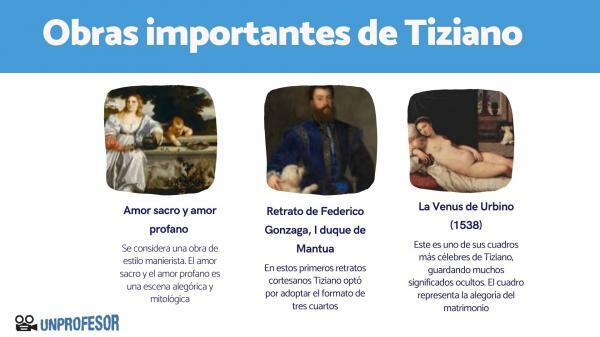
Tiziano Vecellio di Gregorio (Pieve di Cadore, Belluno, Veneto, 1490 - Venice, 1576) is considered the greatest of the masters of the Venetian painting of the 16th century. The large number of works that he painted throughout his extensive career made him a benchmark within the so-called "Venetian School", School of which Veronese, Tintoretto, Cima da Conegliano, Elisabetta Marchioni and Giorgione were also part.
In this lesson from a PROFESSOR we invite you to take a tour of the most important works of the painter Titian and review what are the main stylistic characteristics of this representative of the Renaissance and Mannerism.
Index
- Characteristics of Titian's painting
- Sacred love and profane love (circa 1514)
- Portrait of Federico Gonzaga, 1st Duke of Mantua (1529)
- The Venus of Urbino (1538)
- Charles V at the Battle of Mühlberg (1548)
- Danae receiving the golden shower (1553)
- Allegory of Prudence, 1570
Characteristics of Titian's painting.
Titian is one of the Renaissance painters best known. He stood out for being a excellent draftsman, in addition to the perfection of him as a colorist, managing to introduce a great luminosity thanks to chromatic contrasts and subtle color gradations. He also characterized his style by his magnificent asymmetrical compositions and his energetic, expressive and powerful brushstroke.
A renaissance painter universal that achieved great fame, coming to have several patrons and becoming one of the leading painters of the Habsburgs. Over the years, Tiziano understood painting as a real business and maintained a very active workshop in which he carried out large commissions from him.
Another of his singularities is that Titian, tireless, very versatile and pragmatic, in addition to learning in youth with great figures like Bellini and Giorgione, he became acquainted with all the great currents and trends of Italian art of the time to create a style own self.
Sacred love and profane love (circa 1514)
Sacred love and profane love It is one of the important works of the painter Titian. From the age of nine he worked in the workshop of Sebastiano Zucatto, later moving on to those of Gentile Bellini and Giovanno Bellini respectively. In these early years Titian had already gone through the different phases that Venetian painting had experienced, from the quattrocentist painting in the style of Giorgione.
This is an oil painting that is located in the Borghese Gallery, Rome, and is considered a work in the mannerist style. Sacred love and profane love is a allegorical and mythological scene in which the Renaissance Neoplatonic influence is perceived, which established that earthly beauty is a reflection of heavenly beauty. In terms of style, we can appreciate the mix of typical Titian influences from these early years.
Thus, we can see a certain static order typical of quatrocentism, also noting the influence of Giorgione in how he treats the landscape, while the influence of Bellini is evident in the treatment of the folds of the clothes of the Venus earthly.
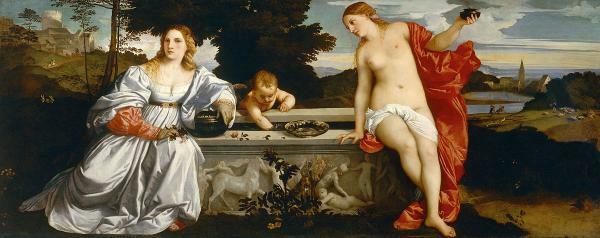
Portrait of Federico Gonzaga, 1st Duke of Mantua (1529)
This is another of the important works of the painter Titian, that of Frederick II Gonzaga (1500-1540), 1st Duke of Mantua. It is an oil on panel dated in 1529 and that conceptually and typologically bears numerous similarities with the one that Titian had already painted between 1523 and 1525 for Alfonso I d'Este.
In these first courtly portraits Titian chose to adopt the three-quarter format and reproduce the textures of the rich fabrics of the clothing with all the preciousness and luxury they had, thus reflecting the social status of the portrayed. It also introduces some elements allusive to the rank and life of the character.
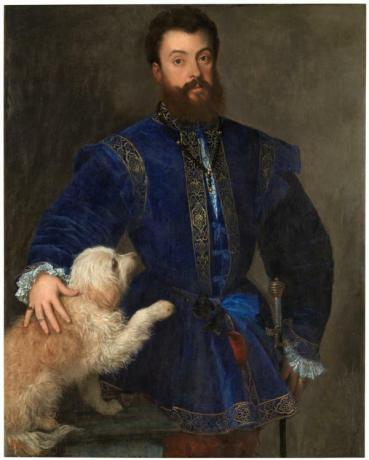
The Venus of Urbino (1538)
This is one of your Titian's most famous paintings, keeping many hidden meanings. The box represents the allegory of marriage showing three of its basic aspects: eroticism, fidelity and motherhood and constitutes the first Venus painted by Titian. The work was commissioned by the Duke of Urbino Guidobaldo II della Rovere as a gift to Giulia Varano, his young wife.
Although inspired by Giorgione's Venus, Titian's Venus is more contemporary and breaks away from Renaissance premises to present the Venus as a real woman. A scene in which realism is reflected in the detail with which Titian paints the Venetian landscape that can be seen through the window on the woman's side. A meticulousness and preciousness which is also reflected in the recreation of the decoration of the palace.
Regarding the composition, the reclining Venus marks the horizontal of the painting, highlighting the verticality of the drapery and the column of the window. The floor tiles direct the viewer's gaze towards the back room, the window column acting as a vanishing point. The warm and light color of the young woman's body contrasts with the colder and darker palette used with the bottom area and the cushions. A resource that further highlights the sensuality of the scene. This Venus of Urbino was inspiration and model for one of the most famous works of the Impressionists, the Olympia by Édouard Manet (1863).
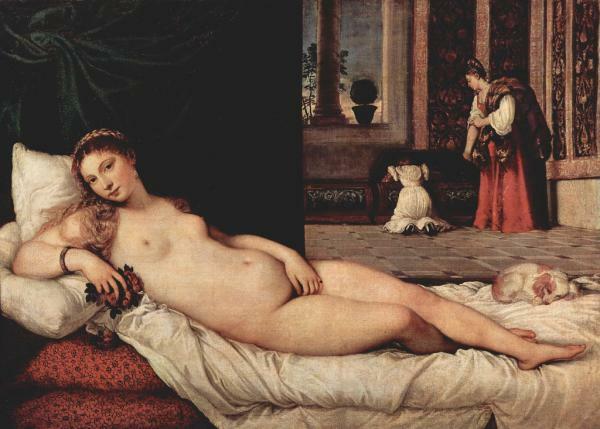
Charles V at the Battle of Mühlberg (1548)
This work by Titian has an exceptional character since there were no precedents for equestrian portraits in Italian painting, taking as references the classical statuary, the Renaissance, German art with works such as El Knight and Death (1514) by Dürer a carving of Maximilian on horseback (1508) by Hans Burgkmair the Old. A courtly artwork in which Titian is placed under the command of Emperor Charles V to, collecting all these precedents, monumentalize the figure of the monarch.
This portrait of Charles V commemorates his victory over the Smalkala League in Mühlberg in 1547. It is an oil on canvas in which the emperor appears dressed in the style of light cavalry and wearing the armor made for him by Desiderius Helmschmid (1513-1579), who carved an image of the Virgin with the Boy. Thus, in the painting the emperor appeared as heir to the Roman tradition, but also as an example of a Christian knight.
Be that as it may, This work by Titian has more political than religious connotations since the imperial propaganda itself tried to focus the victory over the League of Smalkalda as a conflict more political than religious, showing Charles V more like an emperor with enough capacity to rule over such a heterogeneous territory and capable of bringing together the positions of Catholics and Protestants.
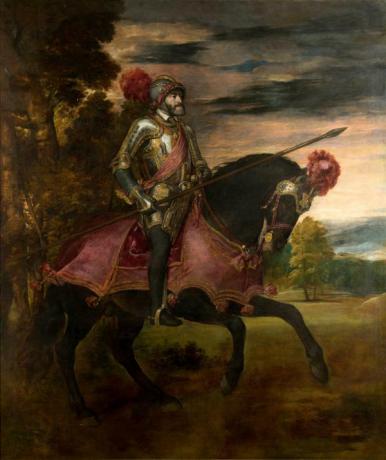
Danae receiving the golden shower (1553)
Among the important works of the painter Titian could not miss this mythological theme box. In this work the myth of Danae is represented. A myth that relates how the girl, daughter of Acrisio, king of Argos, was locked up by him in a tower when he learned of the prophecy that related how she would meet death at the hands of her grandson. Titian captures in the painting the moment when Zeus, by way of rain, visits Danae in the tower to get her pregnant. Perseus will be born from that pregnancy, who, inadvertently, will kill his grandfather Acrisio in Larisa's athletic games.
Titian approaches the work poetically and he offers us a composition in which a powerful diagonal divides the work into two triangular areas. The upper one is dedicated to Zeus, the god who dominates and is action and movement in the form of rain, and a lower triangle in which Danae appears serene and receiving the god. Titian also introduces other contrasts by presenting the naked, beautiful, and candid girl in front of the slave, ugly and old and an accomplice of the god.
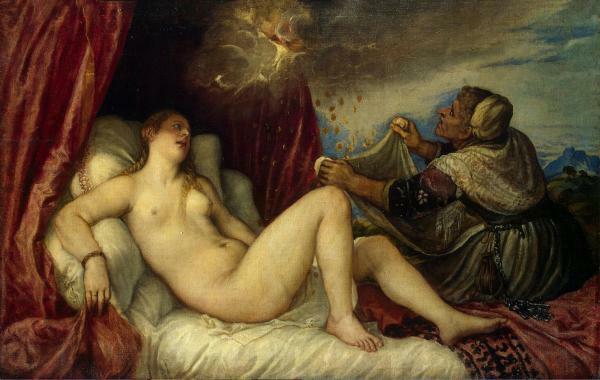
Allegory of Prudence, 1570.
We finish this list with the important works of the painter Titian talking about Allegory of prudence. This is one of the latest works of Titian, being also a mysterious work for its conceptual and symbolic character.
Although there is no agreement among experts on what the painting wants to symbolize, it does seem obvious that Titian wanted to represent the three ages of man, showing how only maturity possesses the virtue of prudence.
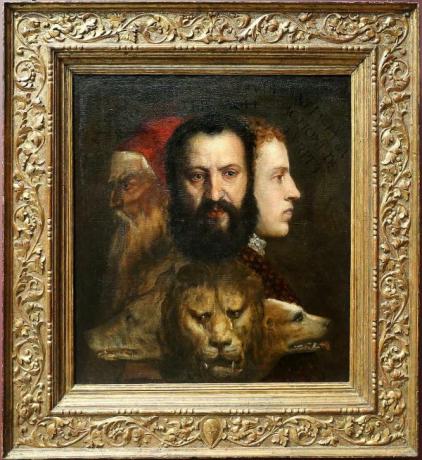
If you want to read more articles similar to Important works of the painter Titian, we recommend that you enter our category of Story.
Bibliography
- Czech, Fernando (1994). Titian and the Hispanic monarchy. Uses and functions of Venetian painting in Spain. 16th and 17th centuries. Nerea.
- Panofsky, E (2003). Titian: problems of iconography. Akal


![FEUERBACH and MARX: similarities and differences [Summary + videos!]](/f/92afafdc14f589d3e05a746845937d51.jpg?width=300&height=200)
